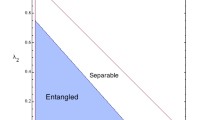Abstract
Theoretical methods for empirical state determination of entangled two-level systems are analyzed in relation to information theory. We show that hidden variable theories would lead to a Shannon index of correlation between the entangled subsystems which is larger than that predicted by quantum mechanics. Canonical representations which have maximal correlations are treated by the use of Schmidt and Hilbert-Schmidt decomposition of the entangled states, including especially the Bohm singlet state and the GHZ entangled states. We show that quantum mechanics does not violate locality, but does violate realism.
Similar content being viewed by others
REFERENCES
W. Band and J. L. Park, “The empirical determination of quantum states,” Found. Phys. 1, 133–144 (1970).
J. L. Park and W. Band, “A general theory of empirical state determination in quantum physics: Part I,” Found. Phys. 1, 211–226 (1971). W. Band and J. L. Park, “A general method of empirical state determination in quantum physics: Part II,” Found. Phys. 1, 339–357 (1971).
U. Leonhardt, Measuring the Quantum State of Light (Cambridge University Press, Cambridge, 1997).
R. Peierls, Surprises in Theoretical Physics (Princeton University Press, Princeton, 1979); More Surprises in Theoretical Physics (Princeton University Press, Princeton, 1991).
L. Allen and J. H. Eberly, Optical Resonance and Two Level Atoms (Wiley, New York, 1975).
Y. H. Shih, A. V. Sergienko, M. H. Rubin, and C. O. Alley, “Two-photon entanglement in type-II parametric down conversion,” Phys. Rev. A. 50, 23–28 (1994). M. H. Rubin, D. N. Klyshko, Y. H. Shih, and A. V. Sergienko, “Theory of two-photon entanglement in type-II optical parametric down-conversion,” Phys. Rev. A. 50, 5122–5133 (1994). Y. H. Shih and A. V. Sergienko, “Observation of quantum beating in a simple beam-splitting experiment: Two-particle entanglement in spin and space-time,” Phys. Rev. A 50, 2564–2568 (1994).
J. Bub, Interpreting the Quantum World (Cambridge University Press, Cambridge, 1997).
A. C. Dotson, “Interpretive principles and the quantum mysteries,” Am. J. Phys. 66, 970–972 (1998).
Y. Aharonov, J. Anandan, and L. Vaidman, “Meaning of the wavefunction,” Phys. Rev. A 47, 4616–4626 (1993).
N. D. Hari Dass and T. Qureshi, “Critique of protective measurement,” Phys. Rev. A 59, 2590–2601 (1999).
A. Barenco, D. Deutsch, A. Ekert, and R. Josza, “Conditional quantum dynamics and logic gates,” Phys. Rev. Lett. 74, 4083–4086 (1995).
V. Scarani, “Quantum computing,” Am. J. Phys. 66, 956–960 (1998).
C. H. Bennet, G. Brassard, C. Crepeau, R. Josza, A. Peres, and W. K. Wooters, “Teleporting an unknown quantum state via dual classical and Einstein-Podolsky-Rosen channels,” Phys. Rev. Lett. 70, 1895–1899 (1993). D. Bouwmeester, J.-W. Pan, K. Mattle, M. Eibel, H. Weinfurter, and A. Zeilinger, “Experimental quantum teleportation,” Nature 390, 575–579 (1997). D. Boschi, S. Branca, F. De-Martini, L. Hardy, and S. Popescu, “Experimental realization of teleporting an unknown pure quantum state via dual classical and Einstein-Podolsky-Rosen channels,” Phys. Rev. Lett. 80, 1121–1125 (1998); A. Furusawa, J. L. Sorensen, S. L. Braunstein, C. A. Fuchs, H. J. Kimble, and E. S. Polzik, “Unconditional quantum teleportation,” Science 282, 706–709 (1998).
A. Aspect, J. Dalibard, and E. Roger, “Experimental test of Bell's inequalities using time-varying analyzers,” Phys. Rev. Lett. 49, 1804–1807 (1982).
D. M. Greenberger, M. A. Horne, A. Shimony, and A. Zeilinger, “Bell's theorem without inequalities,” Am. J. Phys. 58, 1131–1143 (1990).
N. D. Mermin, “Extreme quantum entanglement in a superposition of macroscopically distinct states,” Phys. Rev. Lett. 65, 1838–1840 (1990).
N. D. Mermin, “Quantum mysteries revisited,” Am. J. Phys. 58, 731–734 (1990).
E. Hagley, X. Maitre, G. Nogues, C. Wunderlich, M. Brune, J. M. Raimond, and S. Haroche, “Generation of Einstein-Podolsky-Rosen pairs of atoms,” Phys. Rev. Lett. 79, 1–5 (1997).
B. C. Sanders, “Entangled coherent states,” Phys. Rev. A. 45, 6811–6815 (1992); 46, 2966 (1993). B. C. Sanders, K. S. Lee and M. S. Kim, “Optical homodyne measurements and entangled coherent states,” Phys. Rev. A 52, 735–741 (1995).
S. M. Barnett and S. D. J. Phoenix, “Information theory, squeezing and quantum correlations,” Phys. Rev. A 44, 535–545 (1991).
H. Everett III, “The theory of universal wave function,” in the Many-Worlds Interpretation of Quantum Mechanics, B. S. DeWitt and N. Graham, eds. (Princeton University Press, Princeton, 1973).
H. Everett III, “Relative state formulations of quantum mechanics,” Rev. Mod. Phys. 29, 454–462 (1957).
W. De Baere, A. Mann, and M. Revzen, “Locality and Bell's theorem,” Found. Phys. 29, 67–77 (1999).
A. Peres, Quantum Theory: Concepts and Methods (Kluwer Academic, Dordrecht, 1995).
T. M. Cover and J. A. Thomas, Elements of Information Theory, Chap. 2 (Wiley, New York, 1991).
R. G. Gallager, Information Theory and Reliable Communication (Wiley, New York, 1968).
J. S. Bell, Speakable and Unspeakable in Quantum Mechanics (Cambridge University Press, Cambridge, 1987).
R. Horodecki and P. Horodecki, “Perfect correlations in the Einstein-Podolsky-Rosen experiments and Bell's inequalities,” Phys. Lett. A 210, 227–231 (1996).
Rights and permissions
About this article
Cite this article
Ben-Aryeh, Y., Mann, A. & Sanders, B.C. Empirical State Determination of Entangled Two-Level Systems and Its Relation to Information Theory. Foundations of Physics 29, 1963–1975 (1999). https://doi.org/10.1023/A:1018850602867
Issue Date:
DOI: https://doi.org/10.1023/A:1018850602867



